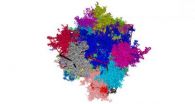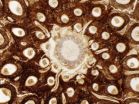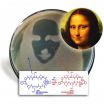(Press-News.org) The experimental and numerical study of the behaviour of polymers in concentrated solutions is a line of research that is still highly active. In the past, it enabled us to understand why materials like rubber have certain elastic properties. A distinctive feature of these systems is that the long "chained" molecules composing them tend to penetrate each other and interweave at their ends forming very durable bonds that make them always return to their initial conformation whenever they are "stretched".
The behaviour of dense solutions of "ring" polymers, i.e., polymers that form closed loops like rings and have no free ends, is very different. Angelo Rosa, a theoretical physicist from the International School for Advanced Studies (SISSA) in Trieste, and Ralf Everaers from the École Normale Supérieure de Lyon devised a highly efficient numerical method to study these materials, a method which they intend to apply to biology in the future.
"Ring polymers – by construction – don't have free ends and so when in a solution they cannot interweave with each other and form bonds as the more common linear polymers do", explains Rosa. "This causes them to behave very differently from linear polymers. So we wanted to understand the physics of these peculiar solutions and we constructed some models of ring polymers that allowed us to predict their behaviour. We then compared the models we created with other earlier simulations conducted with different methods, and found that they confirmed our findings".
"The really interesting thing about our study is that it considerably reduces analysis time, which means the method is highly efficient", the researcher adds. "We found that compared to dense solutions of linear polymers, which form the base of the more common visco-elastic materials such as rubber, these materials are much more fragile because a ring polymer interweaves very little with the others and remains "topologically" always confined within a restricted region".
Rosa and Everaers point out that they will now continue to develop their research in the field of biology. "We think that our models of ring polymers are useful to understand chromosomes dissolved in the cell nucleus", says Rosa. "Even though it isn't a circular polymer, a chromosome behaves in a very similar manner, in that it remains topologically isolated from the other chromosomes dissolved in the cytoplasm for a long time".
INFORMATION: END
It looks like rubber but isn't
What goes on in a concentrated solution of circular polymers?
2014-03-21
ELSE PRESS RELEASES FROM THIS DATE:
Box-shaped pressure vessel for LNG developed by KAIST research team
2014-03-21
Pohang, Republic of Korea, March 21, 2014 – Earlier today, Korean researchers successfully showcased the installation and operation of a box-shaped, high-pressure tank for the storage of liquefied natural gas in Pohang, Republic of Korea. The development was the first of its kind in the world.
Pressure vessels have many applications and are widely used within the petrochemical, energy, and other industrial sectors where the transport and storage of many types of pressurized gases and fluids are essential. Pressure vessels must be designed, manufactured, installed, ...
Researchers develop a novel antibacterial orthodontic bracket cement
2014-03-21
Alexandria, Va., USA – Today, at the 43rd Annual Meeting & Exhibition of the American Association for Dental Research (AADR), held in conjunction with the 38th Annual Meeting of the Canadian Association for Dental Research, Mary Anne Sampaio de Melo, from the University of Maryland, Baltimore, will present a research study titled "Antibacterial Orthodontic Cement Containing a Quaternary Ammonium Monomer Dimethylaminododecyl Methacrylate."
Demineralized lesions in enamel around orthodontic brackets are caused by acids from biofilm accumulation. The objectives of this study ...
Researchers at LSTM unlock the secret of multiple insecticide resistance in mosquitoes
2014-03-21
Researchers at LSTM have discovered how unprecedented multiple and extreme-level resistance is generated in mosquitoes found in the rice fields of Tiassalé in southern Côte d'Ivoire. The paper, "CYP6 P450 enzymes and ACE-1 duplication produce extreme and multiple insecticide resistance in the malaria mosquito Anopheles gambiae" published in PLoS Genetics today, highlights the combination of stringently-replicated whole genome transcription profiling, in vivo transgenic gene expression and in vitro metabolism assays to identify and validate genes from the P450 detoxification ...
Critical illness polyneuropathy and myopathy: Nerve injury and regeneration
2014-03-21
Critical illness polyneuropathy and critical illness myopathy are frequent complications of severe illness that involve sensorimotor axons and skeletal muscles, respectively. Differentiating critical illness polyneuropathy from Guillain-Barré syndrome, especially the axonal variants, may be difficult on purely clinical grounds, as Guillain-Barré syndrome is known for its variable atypical manifestations. Prof. Hongliang Zhang and team from the First Bethune Hospital, Jilin University in China provide the latest knowledge concerning the pathophysiology of critical illness ...
Lessons offered by emerging carbon trading markets
2014-03-21
DURHAM, N.C. -- Although markets for trading carbon emission credits to reduce greenhouse gas emissions have stalled in United States federal policy-making, carbon markets are emerging at the state level within the U.S. and around the world, teaching us more about what does and doesn't work.
In a Policy Forum article in the March 21 edition of Science magazine, Duke University's Richard Newell, William Pizer and Daniel Raimi discuss the key lessons from a decade of experience with carbon markets. They also discuss what it might take for these markets to develop and possibly ...
Who reprograms rat astrocytes into neurons?
2014-03-21
To date, it remains poorly understood whether astrocytes can be easily reprogrammed into neurons. Mash1 and Brn2 have been previously shown to cooperate to reprogram fibroblasts into neurons. Dr. Yongjun Wang and team from Shanghai University of Traditional Chinese Medicine in China found that and found that Brn2 was expressed in astrocytes from 2-month-old Sprague-Dawley rats, but Mash1 was not detectable. Thus, the researchers hypothesized that Mash1 alone could be used to reprogram astrocytes into neurons. Murine stem cell virus (MSCV)-Mash1 recombinant plasmid was constructed ...
Unique chromosomes preserved in Swedish fossil
2014-03-21
Researchers from Lund University and the Swedish Museum of Natural History have made a unique discovery in a well-preserved fern that lived 180 million years ago. Both undestroyed cell nuclei and individual chromosomes have been found in the plant fossil, thanks to its sudden burial in a volcanic eruption.
The well-preserved fossil of a fern from the southern Swedish county of Skåne is now attracting attention in the research community. The plant lived around 180 million years ago, during the Jurassic period, when Skåne was a tropical region where the fauna was dominated ...
A study using Drosophila flies reveals new regulatory mechanisms of cell migration
2014-03-21
Cell migration is highly coordinated and occurs in processes such as embryonic development, wound healing, the formation of new blood vessels, and tumour cell invasion. For the successful control of cell movement, this process has to be determined and maintained with great precision. In this study, the scientists used tracheal cells of the fruit fly Drosophila melanogaster to unravel the signalling mechanism involved in the regulation of cell movements.
The research describes a new molecular component that controls the expression of a molecule named Fibroblast Growth ...
Switching an antibiotic on and off with light
2014-03-21
This news release is available in German. Scientists of the KIT and the University of Kiev have produced an antibiotic, whose biological activity can be controlled with light. Thanks to the robust diarylethene photoswitch, the antimicrobial effect of the peptide mimetic can be applied in a spatially and temporally specific manner. This might open up new options for the treatment of local infections, as side effects are reduced. The researchers present their photoactivable antibiotic with the new photomodule in a "Very Important Paper" of the journal "Angewandte Chemie". ...
cfaed presents the new microchip 'Tomahawk 2' at the DATE'14 in Dresden
2014-03-21
The Center for Advancing Electronics Dresden (cfaed) presents its new microchip 'Tomahawk 2' at the DATE'14 Conference in the International Congress Center Dresden from March 24 to 28, 2014. The new Tomahawk is extremely fast, energy-efficient and resilient. It is a heterogeneous multi-processor which can easily integrate very different kinds of devices. The researchers of the Cluster of Excellence for microelectronics of Technische Universität Dresden use the new prototype to prepare the so-called 'tactile internet'. With this, very big data volumes shall be transmitted ...
LAST 30 PRESS RELEASES:
Tracing the quick synthesis of an industrially important catalyst
New software sheds light on cancer’s hidden genetic networks
UT Health San Antonio awarded $3 million in CPRIT grants to bolster cancer research and prevention efforts in South Texas
Third symposium spotlights global challenge of new contaminants in China’s fight against pollution
From straw to soil harmony: International team reveals how biochar supercharges carbon-smart farming
Myeloma: How AI is redrawing the map of cancer care
Manhattan E. Charurat, Ph.D., MHS invested as the Homer and Martha Gudelsky Distinguished Professor in Medicine at the University of Maryland School of Medicine
Insilico Medicine’s Pharma.AI Q4 Winter Launch Recap: Revolutionizing drug discovery with cutting-edge AI innovations, accelerating the path to pharmaceutical superintelligence
Nanoplastics have diet-dependent impacts on digestive system health
Brain neuron death occurs throughout life and increases with age, a natural human protein drug may halt neuron death in Alzheimer’s disease
SPIE and CLP announce the recipients of the 2025 Advanced Photonics Young Innovator Award
Lessons from the Caldor Fire’s Christmas Valley ‘Miracle’
Ant societies rose by trading individual protection for collective power
Research reveals how ancient viral DNA shapes early embryonic development
A molecular gatekeeper that controls protein synthesis
New ‘cloaking device’ concept to shield sensitive tech from magnetic fields
Researchers show impact of mountain building and climate change on alpine biodiversity
Study models the transition from Neanderthals to modern humans in Europe
University of Phoenix College of Doctoral Studies releases white paper on AI-driven skilling to reduce burnout and restore worker autonomy
AIs fail at the game of visual “telephone”
The levers for a sustainable food system
Potential changes in US homelessness by ending federal support for housing first programs
Vulnerability of large language models to prompt injection when providing medical advice
Researchers develop new system for high-energy-density, long-life, multi-electron transfer bromine-based flow batteries
Ending federal support for housing first programs could increase U.S. homelessness by 5% in one year, new JAMA study finds
New research uncovers molecular ‘safety switch’ shielding cancers from immune attack
Bacteria resisting viral infection can still sink carbon to ocean floor
Younger biological age may increase depression risk in older women during COVID-19
Bharat Innovates 2026 National Basecamp Showcases India’s Most Promising Deep-Tech Ventures
Here’s what determines whether your income level rises or falls
[Press-News.org] It looks like rubber but isn'tWhat goes on in a concentrated solution of circular polymers?





